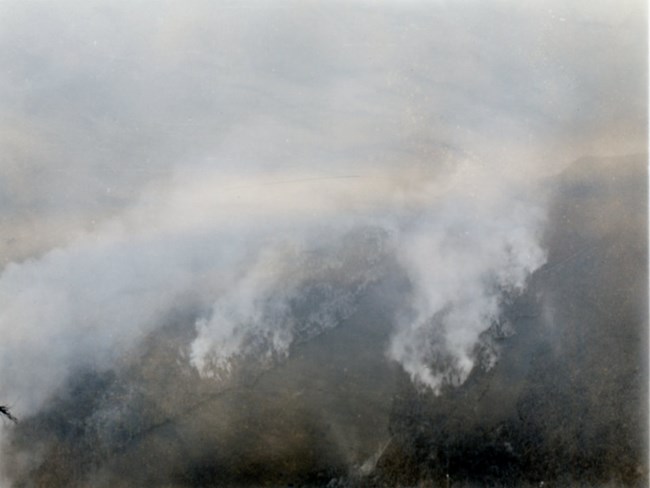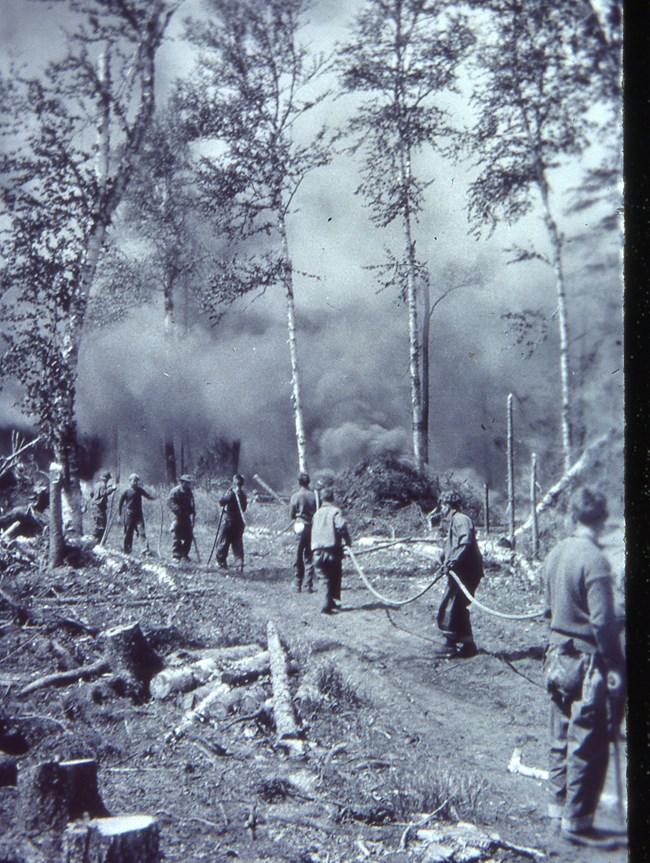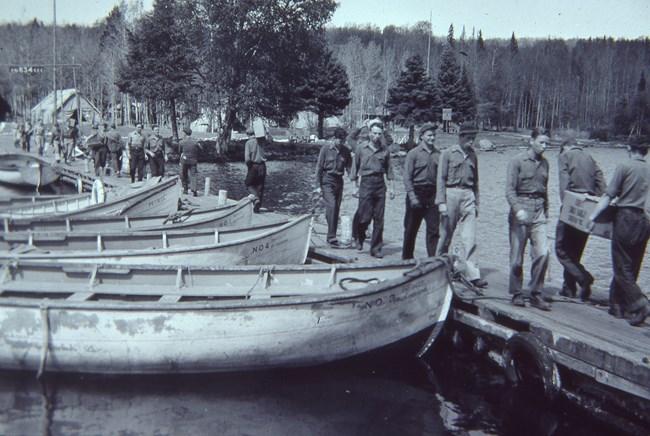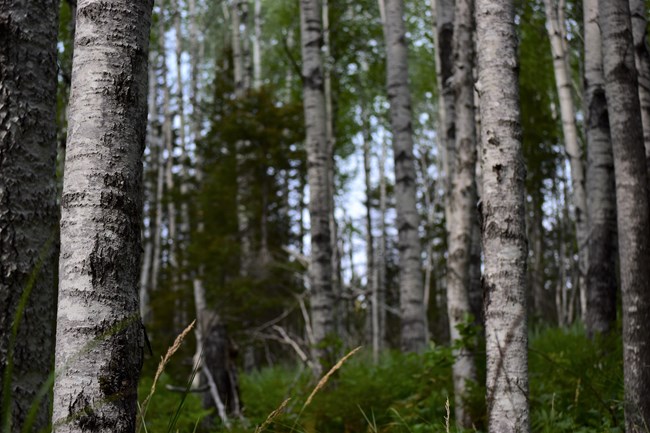Last updated: September 13, 2023
Article
Isle Royale Fire of 1936

National Visual Inventory Cards 30-016
Fire on Isle Royale
In 1931, a new national park at Isle Royale had been authorized by Congress. To support this new endeavor, the Civilian Conservation Corps (CCC) was enlisted to come to the island and develop park infrastructure. The CCC spent the summer months constructing buildings, housing, docks, and campgrounds. Simultaneously, the Consolidated Paper Company was logging balsam fir and spruce pulpwood from their holdings on the island.
The summer of 1936 was hot and dry. Temperatures were far above average. A drought was being felt across the northern Midwest, and Isle Royale was no exception.
On July 25, 1936, a fire started at or near the location of the Consolidated Paper Company’s lumber mill camp on Siskiwit Bay, and both the CCC enrollees and the loggers would find themselves battling a blaze. The cause of this fire was never officially determined, but it was destined to have a more profound effect on the natural and human history of Isle Royale than any other single historical event.

National Visual Inventory Cards 30-011
Blaze Begins
Immediately after the fire was initially reported, 160 men from two on-island CCC camps were called into action. At the time firefighting began, the fire had already grown to 200 acres.
By July 26, 40 loggers joined the firefighting efforts. The 200 men appeared to have the fire under control, but late the same day, strong winds blew the flames over fire lines. By July 30, the fire had grown to 4,000 acres. The fire reportedly burned with such intensity on the night of July 31 that reflections could be seen over 40 miles away on Michigan's mainland. On August 1, the blaze began to threaten the CCC and lumber camps. However, with the addition of 400 CCC reinforcements arriving from the mainland, the camps were able to be saved, along with 100,000 dollars worth of lumber. After more than 5,000 acres were burned, the fire was reported as being contained on August 4.

NPS
Spot Fires Blow Up
While firefighters worked to control the initial blaze, survey by airplane revealed two sizeable spot fires on August 2. After receiving this report, firefighters arrived at the first spot fire, south of Lake Desor, to find it had already burned an area three miles long and two miles wide.
By now firefighters were arriving from the mainland in a steady flow, along with much needed supplies from Fort Brady at Sault Ste. Marie, Michigan. Six new camps were established to accommodate firefighters battling the fire south of Lake Desor, which had made a run east and almost completely surrounded Siskiwit Lake. This fire would go on to burn approximately 17,000 acres, becoming the largest fire in Isle Royale history.
The second of the two spot fires headed northeast toward Little Todd Harbor from west Lake Desor. By August 12, this fire burned approximately 3,000 acres.
Fires Contained
By mid-August, 1,800 men were battling the fire, 1,600 of which were CCC enrollees, with the remainder being loggers or island residents. 19 days after the initial spark, the blaze finally showed signs of letting up. Shifting winds gave firefighters a chance to backfire and construct effective fire lines, preventing the fire’s spread from reaching the resort areas of eastern Isle Royale. On August 18, all three fires were officially declared out after heavy rain fell across the island. 27,000 acres were burned in total.

NPS
Unfavorable Conditions
Tough environmental conditions likely contributed to the spread of the 1936 Fire. At the time, Isle Royale's ground cover was composed mostly of mosses, which becomes highly flammable when fire effects are intensified by drought. The rocky terrain and outcroppings across the island made it impossible to utilize mechanized equipment, such as tractor plows, for fire line construction. The isolated, inland locations of the fires made response time slow and the use of water pumps difficult.
Camp Life
Fire camp conditions were displeasing. With an influx of 1,600 CCC enrolles arriving as reinforcements, there often wasn't enough food to go around. When meat came in with food resupplies, it often arrived spoiled or in short supply. On August 18, firefighters reportedly had only beans and cocoa for breakfast, and refused to go to work until more food arrived. Firefighters also reported foul sanitation and severe fly infestations.
Along with food, there also wasn't enough tobacco to go around during the post-fire conservation efforts. After rationing for weeks, tobacco officially ran out on August 20, resulting in CCC enrollees going on strike August 25. That afternoon, tobacco was promptly brought in, and the firefighters withdrew their strike.

Abby Winters
Lasting Impact
In total, the Fire of 1936 burnt 27,000 acres, or approximately 20 percent of the island, in three major, seperate fires. The impacts of this fire can still be seen on Isle Royale's landscape and ecology today. In the middle section of the Greenstone Ridge Trail, passing through decades-old burn areas, dense forests of birch and aspen are common, while few conifers are present. Birch and aspen trees are the first to grow in sunny, open, disturbed areas, and also have a low flammability, compared to the very high flammability of common conifers. Here and there, old, charred stumps can be spotted, and long-dead fallen pines rot on the forest floor. All these signs are reminders of the most destructive single event in Isle Royale's history.
Timeline
A fire starts near Consolidated Paper Company's Siskiwit Bay lumber mill camp. 160 CCC enrollees are called into action as the fire grows to 200 acres.
40 loggers join the fire fight. The fire seems to be contained, until strong winds blow flames over control lines.
The fire burns so intensely that it can reportedly be seen from Michigan's mainland, over 40 miles away.
The fire begins to threaten CCC and lumber camps. Additional firefighter reinforcements help save the camps.
Airplane survey reveals two new spot fires on Isle Royale near Lake Desor.
-
The initial fire is contained after burning 5,000 acres.
-
Firefighters arrive at the larger of the two spot fires, south of Lake Desor. Six new fire camps are established. Simultaneously, firefighters arrive at the smaller spot fire, north of Lake Desor, and establish two new fire camps.
The larger spot fire reportedly burns within six miles of Chippewa Harbor.
The larger spot fire has burned 17,000 acres, coming within one mile of Lake Richie. The smaller spot fire has burned 3,000 acres.
1,800 men are on Isle Royale battling the fires. This includes 1,600 CCC enrollees, and 200 loggers and island residents.
The blaze shows signs of letting up. Winds shift, allowing firefighters to backfire and construct effective fire lines.
All three fires on Isle Royale are officially declared out.
